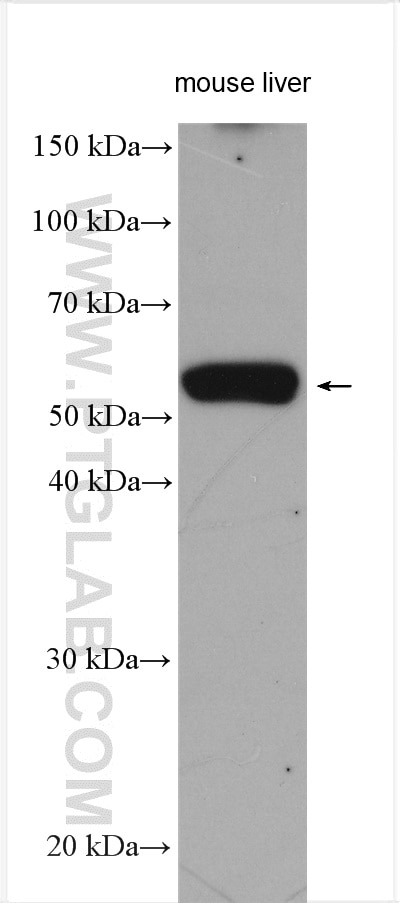Validation Data Gallery
Filter:
Tested Applications
| Positive WB detected in | mouse liver tissue |
Recommended dilution
| Application | Dilution |
|---|---|
| Western Blot (WB) | WB : 1:2000-1:10000 |
| It is recommended that this reagent should be titrated in each testing system to obtain optimal results. | |
| Sample-dependent, Check data in validation data gallery. | |
Published Applications
| WB | See 2 publications below |
| ELISA | See 1 publications below |
Product Information
14663-1-AP targets NOTUM in WB, ELISA applications and shows reactivity with human, mouse samples.
| Tested Reactivity | human, mouse |
| Cited Reactivity | human, rat |
| Host / Isotype | Rabbit / IgG |
| Class | Polyclonal |
| Type | Antibody |
| Immunogen | NOTUM fusion protein Ag6338 相同性解析による交差性が予測される生物種 |
| Full Name | notum pectinacetylesterase homolog (Drosophila) |
| Calculated molecular weight | 56 kDa |
| Observed molecular weight | 56 kDa |
| GenBank accession number | BC060882 |
| Gene Symbol | NOTUM |
| Gene ID (NCBI) | 147111 |
| RRID | AB_2878073 |
| Conjugate | Unconjugated |
| Form | Liquid |
| Purification Method | Antigen affinity purification |
| UNIPROT ID | Q6P988 |
| Storage Buffer | PBS with 0.02% sodium azide and 50% glycerol , pH 7.3 |
| Storage Conditions | Store at -20°C. Stable for one year after shipment. Aliquoting is unnecessary for -20oC storage. |
Protocols
| Product Specific Protocols | |
|---|---|
| WB protocol for NOTUM antibody 14663-1-AP | Download protocol |
| Standard Protocols | |
|---|---|
| Click here to view our Standard Protocols |
Publications
| Species | Application | Title |
|---|---|---|
Arch Oral Biol Notum suppresses the osteogenic differentiation of periodontal ligament stem cells through the Wnt/Beta catenin signaling pathway. | ||
Front Pharmacol Exploratory study of sea buckthorn enhancing QiangGuYin efficacy by inhibiting CKIP-1 and Notum activating the Wnt/β-catenin signaling pathway and analysis of active ingredients by molecular docking | ||
Heliyon Overexpression of RBM15 modulated the effect of trophoblast cells by promoting the binding ability between YTHDF2 and the CD82 3'UTR to decrease the expression of CD82 |
